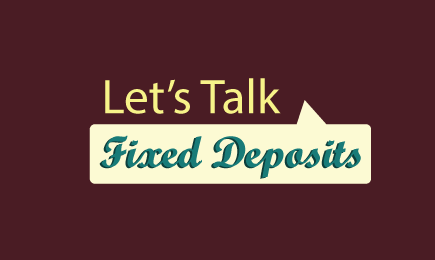
In a balanced diet, you need the right proportion of carbohydrates, proteins and fibre. Similarly, to have a balanced finance portfolio, the right proportion of high-growth instruments and risk-free instruments are needed.
In an investment portfolio, stocks market and mutual funds are high-return instruments but the risk level is also very high. Bank Fixed Deposits (FDs) are low-risk instruments.
Not only are FDs safe havens to park your funds, they also offer a decent interest on deposit. A regular monthly income can be generated out of it.
There are other reasons as well that make FDs an attractive investment option. Let’s explore these.
FD interest rates trump regular savings accounts
Many investors are now worried about the possible interest rate reductions for FDs, as the apex bank of India, the RBI, has been slashing repo rates since the beginning of this year.
On the other hand, the government is paying heed to the pleading of banks to bring down the rates of small savings schemes like post-office savings. Stability in the overall deposit rates in this way could mean that FDs will remain stable and at par with any debt instruments.
Currently, on an average, banks offer interest rates ranging between 8% and 9% for FDs as against 4% to 5% for savings accounts. The return on FDs is about double that of savings accounts – making an FD more attractive to park your money in than a savings account.
The interest is compounded quarterly
Some fixed maturity mutual funds or bonds also offer similar kinds of return, or slightly higher. But if you compare these over a long period of time, you will notice that FDs offer a better return. This is because the interest is calculated and compounded quarterly.
Every three months, the interest earned is added with the main principle and interest is calculated on the basis of principle. For instance, if Rs 1,00,000 is deposited with a bank offering an 8.5% interest rate for a 10-year period, then, according to the simple interest theory, it is supposed to generate Rs. 85,000. But as it is compounded quarterly, it actually yields Rs 1,31,890. After compounding, the annualised yield becomes 13.18% – far above from any other instrument.
Helpful hint: You can calculate FD returns using an FD calculator online.
FDs can be broken any time
Liquidity is an important factor for any investment. How quickly can you encash your investment? FDs can be broken at any point of time – within one day’s notice. Banks may deduct around 1% interest if the FD is broken prematurely. However, this easy liquidity option is not available with most other investment instruments, not even with post-office savings.
Most mutual funds and equity-linked insurances have a lock-in period of 3 to 5 years. Though money can be withdrawn any time from the equity market, chances are you may book a loss from a profitable deal purely because of bad timing.
Tax relief
Interest earned on fixed deposits is considered taxable income. However, if you submit Form 15G in the month of April, then the bank will not deduct tax.
If you do not fall under any tax bracket, then you do not need to do anything further. However, if your income is taxable, then you need to file a tax return in future and mention this.
Tax-free FDs are also available, making them a popular tax-saving option. However, the interest rates of those FDs are a bit lower as compared to regular FDs and they come with a lock-in period of five years.
No brokerage
Consider any investment – every investment instrument is associated with brokerage, agent’s commission or, at the very least, maintenance costs. Even post-office investments are not excluded from such commissions.
You will have to pay brokerages, security transaction costs and depositary maintenance charges if you have investments in stock market and mutual funds. No such charges are required in case of bank FDs, especially in no-frill accounts of public sector banks. If all these investment servicing hidden costs are considered, then bank FDs are the most economic instruments.
All these make an FD a must-have in your portfolio. Most banks offer services through online banking and mobile banking. Now, you can simply open and monitor FDs from your mobile phone or computer.
So, do risk-free returns mean tension-free returns? In these busy days, if you can get a return of 8% to 9% just sitting back, without any headaches or stress, the answer is more or less staring you in the face!
